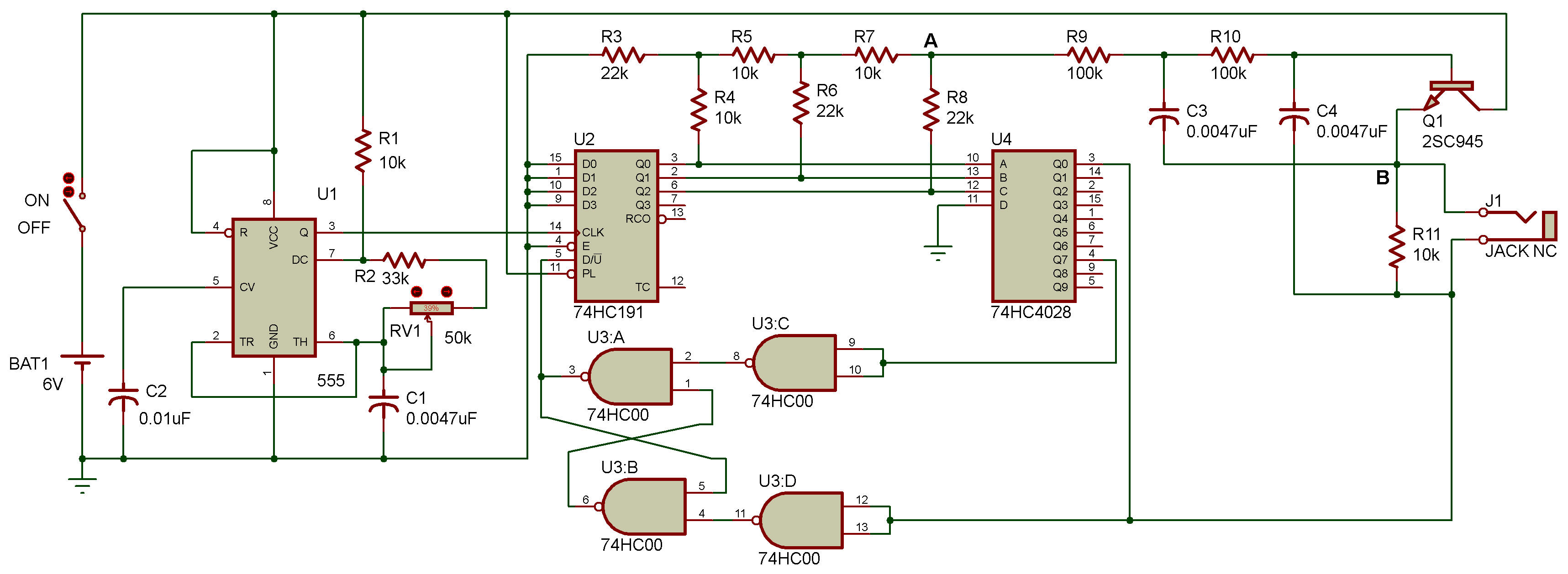
Sine wave oscillator using D-A converter

In this project, you are going to generate sine waves using digital technology. Here, a counter shifts up and down, and its output goes through digital-to-analog (D-A) conversion to make a stepped sine wave in the first stage. The wave passes through a filter to form a smooth sine wave in the second stage. (See Figure 1.)
When the circuit is completed, listen to the result from the earphone.
When you finish wiring, turn power ON. Listen to the sound from the earphone. You should hear a tone of constant frequency. Try to rotate the control volume clockwise. The tone changes to a higher pitch. It changes to a lower pitch with the counterclockwise rotation.
The counter U2 receives clock pulses from the oscillator U1 and counts them up. The outputs QA - QC are decoded by the decoder U3.
As the counter U2 counts up, the output Q7 of U3 resets the flip-flop U4, and the counter U2 then counts down until the output Q0 of U3 sets the flip-flop U4.
This count-up/count-down cycle is repeated. In the meantime, the outputs of the counter U2 are D-A converted through the resistor network and a stepped sine wave is produced at point A in Figure 1. Then it passes through a low-pass filter to provide the sine wave shown at point B.

| Bill Of Materials For Sine wave oscillator using d-a converter | ||||||
| 11 Resistors | ||||||
| Quantity: | References | Value | ||||
| 5 | R1, R4, R5, R7, R11 | 10k | ||||
| 1 | R2 | 33k | ||||
| 3 | R3, R6, R8 | 22k | ||||
| 2 | R9, R10 | 100k | ||||
| 4 Capacitors | ||||||
| Quantity: | References | Value | ||||
| 3 | C1, C3, C4 | 0.0047uF | ||||
| 1 | C2 | 0.01uF | ||||
| 4 Integrated Circuits | ||||||
| Quantity: | References | Value | ||||
| 1 | U1 | 555 | ||||
| 1 | U2 | 74HC191 | ||||
| 1 | U3 | 74HC00 | ||||
| 1 | U4 | 74HC4028 | ||||
| 1 Transistors | ||||||
| Quantity: | References | Value | ||||
| 1 | Q1 | 2SC945 | ||||
| 4 Miscellaneous | ||||||
| Quantity: | References | Value | ||||
| 1 | BAT1 | 6V | ||||
| 1 | J1 | JACK NC | ||||
| 1 | ON | OFF | ||||
| 1 | RV1 | 50k | ||||
